Antique Japanese Pottery Satsuma Ware (Satsuma Yaki-05)
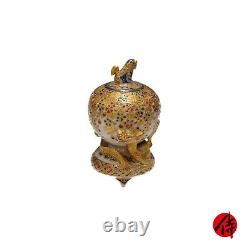
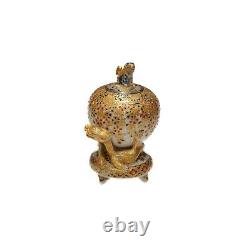
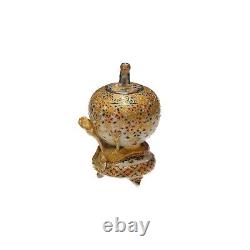
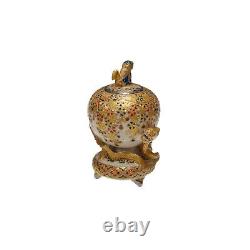
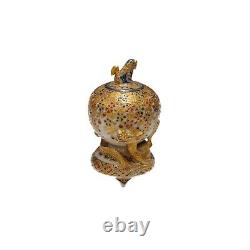

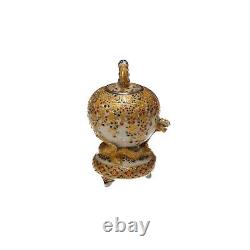
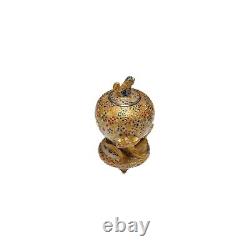
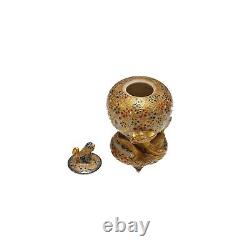


Welcome to Samurai Gift, official antique shop of Samurai Museum in Tokyo. Antique Japanese Pottery - Satsuma Ware (Satsuma Yaki-05). Satsuma Ware, Karajishi Ryu zu. Signed but cannot be read.
This item is a white color base Satsuma ware. Its pale cream-colored pot is brightly decorated with red, blue, and green.
In addition, the gold coloring gives it a luxurious look for this work. This type of Satsuma ware is made from white soil. And this raw material was extracted only in a minimal area in the territory of the Satsuma. Therefore, it was treated as a valuable item. If you look at the surface of this pot, you will find delicate cracks.
It is called the Kan-Nyu?? , and it was made because the contraction percentage is different between the soil and glaze. So, these minute cracks are not considered damage when we enjoy the Satsuma ware. People think of it as a characteristic flavor.At the top of this pot, you would find a dog-liked animal motif. We believe this motif is the Karajishi???
Means a lion in Japanese, and the Karajishi is a lion brought from the continent to Japan in the Toh period? The Karajishi typically has curly hair for its head, neck, body, and tail, as seen in this work. In Buddhism, the Karajishi is regarded as a symbol of wisdom, and Monju Bosatu????
According to a theory, the Karajishi is the origin of Komainu?? Stone guardian dogs that exorcize evil spirits. It shows this beast motif has been familiar to Japanese people since ancient times. Cherry blossoms and chrysanthemums are designed on the upper side of this pot. Cherry blossom is one of the seasonal things of spring, and it has been loved for a long time in Japan. A theory says that the god of grain exists in cherry blossoms. Therefore, this flower pattern has been treated as the symbol of a plentiful harvest. A long time ago, chrysanthemum flowers were used as a medicine for obtaining a long life, and it was brought to Japan from the continent with this thought in the Nara period (648-781). Chrysanthemum symbolizes fall, and people have greatly appreciated it since ancient times. As its petals form radially, the chrysanthemum has been likened to the sun. That is why this flower pattern is treated as the symbol of perpetual youth and longevity or good health. The chrysanthemum is one of the popular classical motifs for Japanese people. If you focus on the lower part of this pot, you will find that a dragon is twinning around it. Same as other motifs, it is gorgeously colored with golden paint. Initially, the dragon was an imaginary creature found in ancient foreign traditions or myths. Furthermore, it is regarded as a symbol of auspicious signs. Its body is likened to nine animals: antlers are deer, the head is a camel, eyes are demons, the neck is a snake, belly is Mizuchi? A mythical animal in Japan which looks like a snake and has a horn and four legs, scales are fish, claws are falcons, palms are tigers, and ears are cows. It was thought that the dragon would reign at the top of all animals because of its odd-looking appearance.This Satsuma ware pot is decorated with several auspicious motifs. We hope you enjoyed the meanings of each of them and love this pot. As this item is an antique, please check each photo and ensure its condition. Satsuma ware is a kind of Japanese pottery made in Satsuma Province Kagoshima Pref. From 1529 to 1598, the battle of Bunroku, Keichou??
It was the conflict between Japan and the Korean Peninsula. After this troop dispatch to the Korean Peninsula, Yoshihiro Shimazu, who was the 17th feudal lord of the Satsuma domain, brought back more than 80 Korean potters to Japan. They opened kilns in various parts in the Satsuma domain and made different pottery types depending on their locations or style of a potter.
They were categorized into five styles: Naeshirogawa-Kei???? And all of them are called Satsuma Yaki.
Satsuma ware is classified as two groups based on the differences of each characteristic. Shiro-Satsuma is also called Shiromon??? It is made of white clay and is carefully molded. And then it is covered with a transparent glaze. Fine cracks are seen on the surface of the pottery.Usually, it is decorated with gorgeous designs with gold, red, green, purple, and yellow. Shiro-Satsuma was made for the domain so that the domain and the Shimazu family had it.
Kuro-Satsuma is also known as Kuromon??? It has been appreciated as a daily household appliance for ordinary people in contrast to Shiromon. As it uses ferrous soil, Kuro-Satsuma has black color and has a simple and sturdy body.
Satsuma ware was exhibited in the 1867 Paris World Expo and regarded highly in Europe. Since then, Satsuma ware is called "SATSUMA" and loved not only in Japan but overseas. 5.8 cm × 10 cm (approximately).
Please note that your use of e-bay is governed by the following terms. These Terms are between you and Samurai Museum and govern our respective rights and obligations. Samurai Gift is not responsible for any lost package that is incorrectly addressed due to customer error.If you enter your address incorrectly, you are bound to inform us immediately (within 24 hours of your order). It will normally takes 5-14 days for the item to arrive at your given address after we dispatch it.
Thank you for checking our item. This item is in the category "Antiques\Asian Antiques\Japan\Vases". The seller is "samuraimuseum888" and is located in this country: JP. This item can be shipped to North, South, or Latin America, all countries in Europe, all countries in continental Asia, Australia.
- Primary Material: soil
- Color: Ivory
- Original/Reproduction: Antique Original
- Region of Origin: Japan
- Maker: Signed but cannot be read
- Age: Unknown

